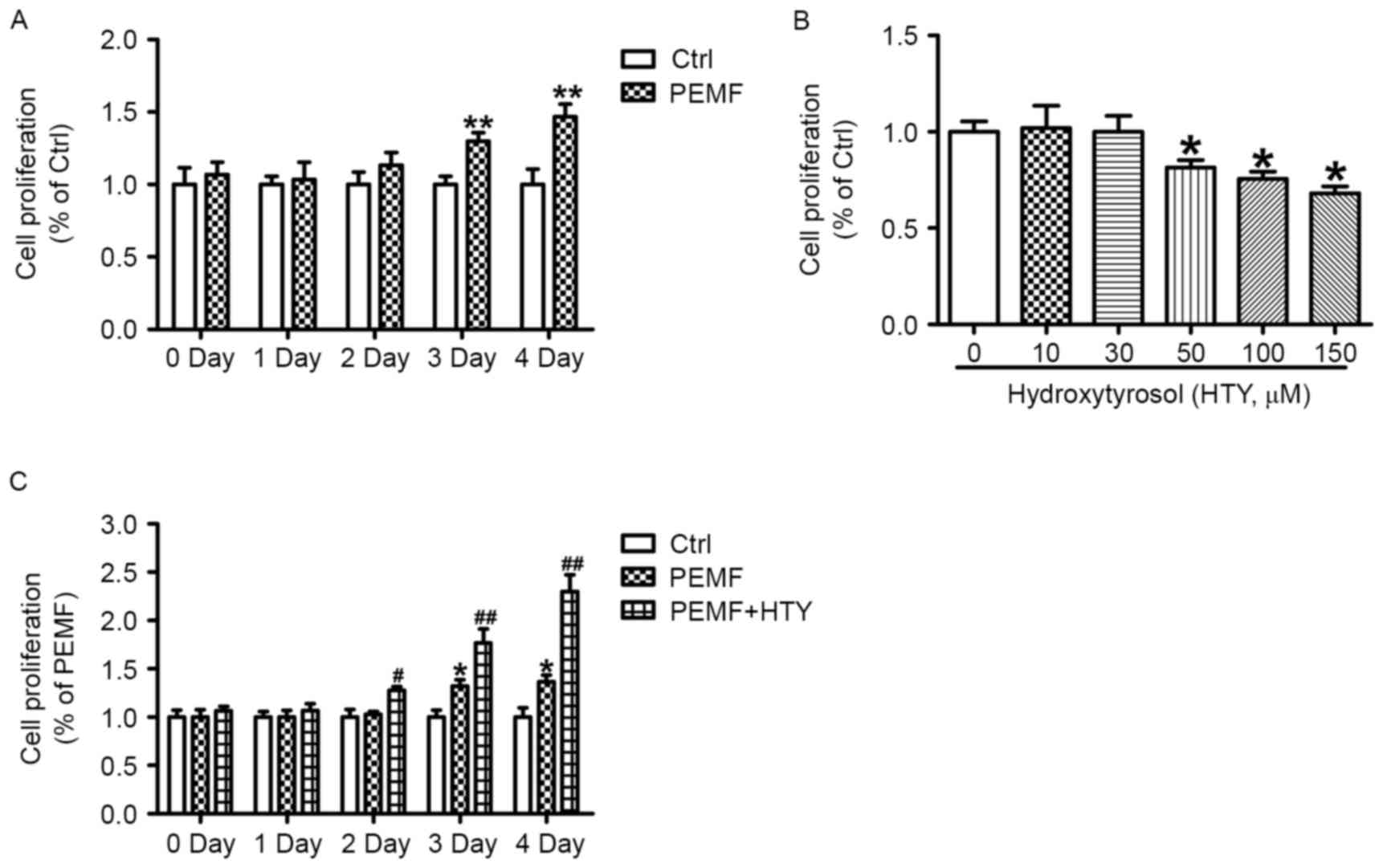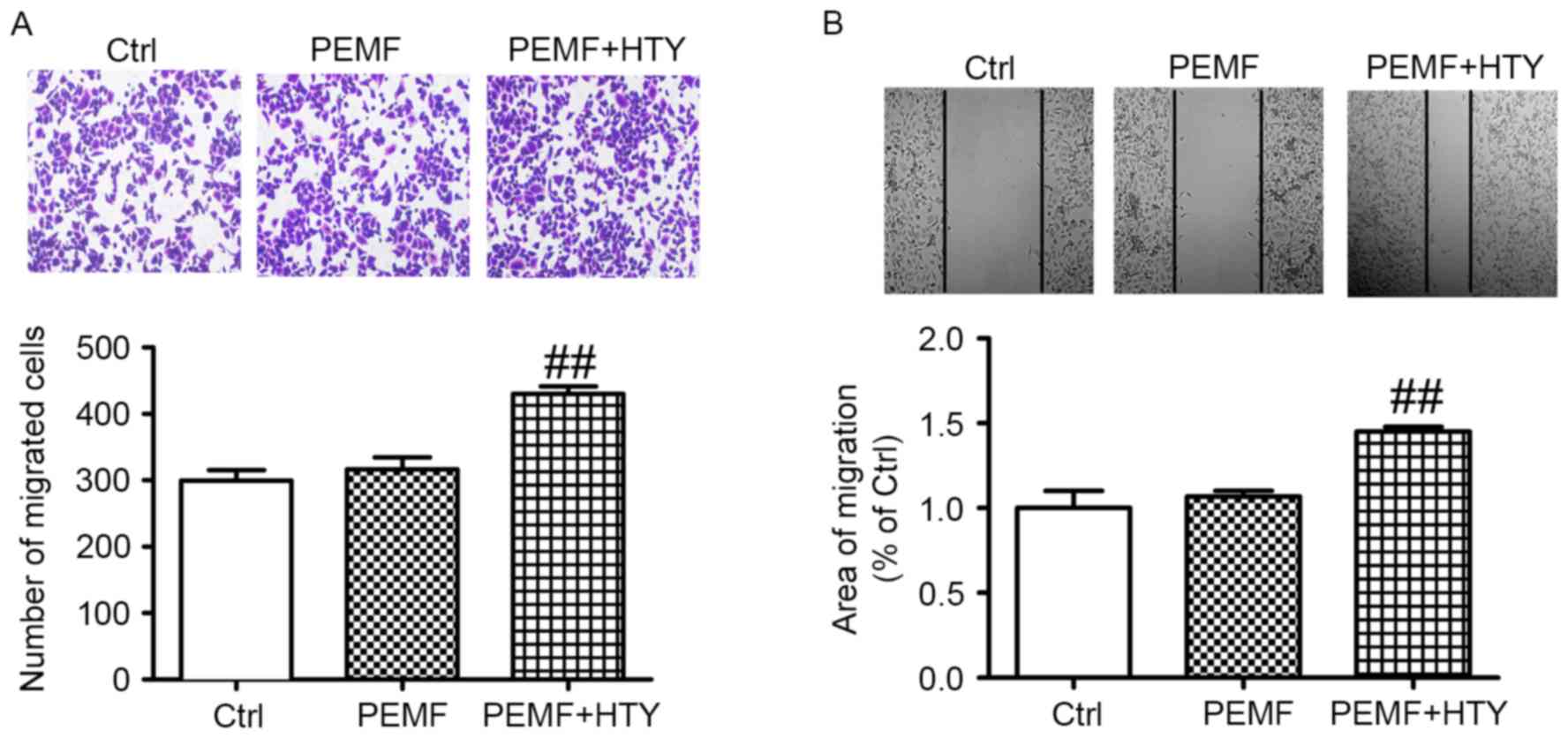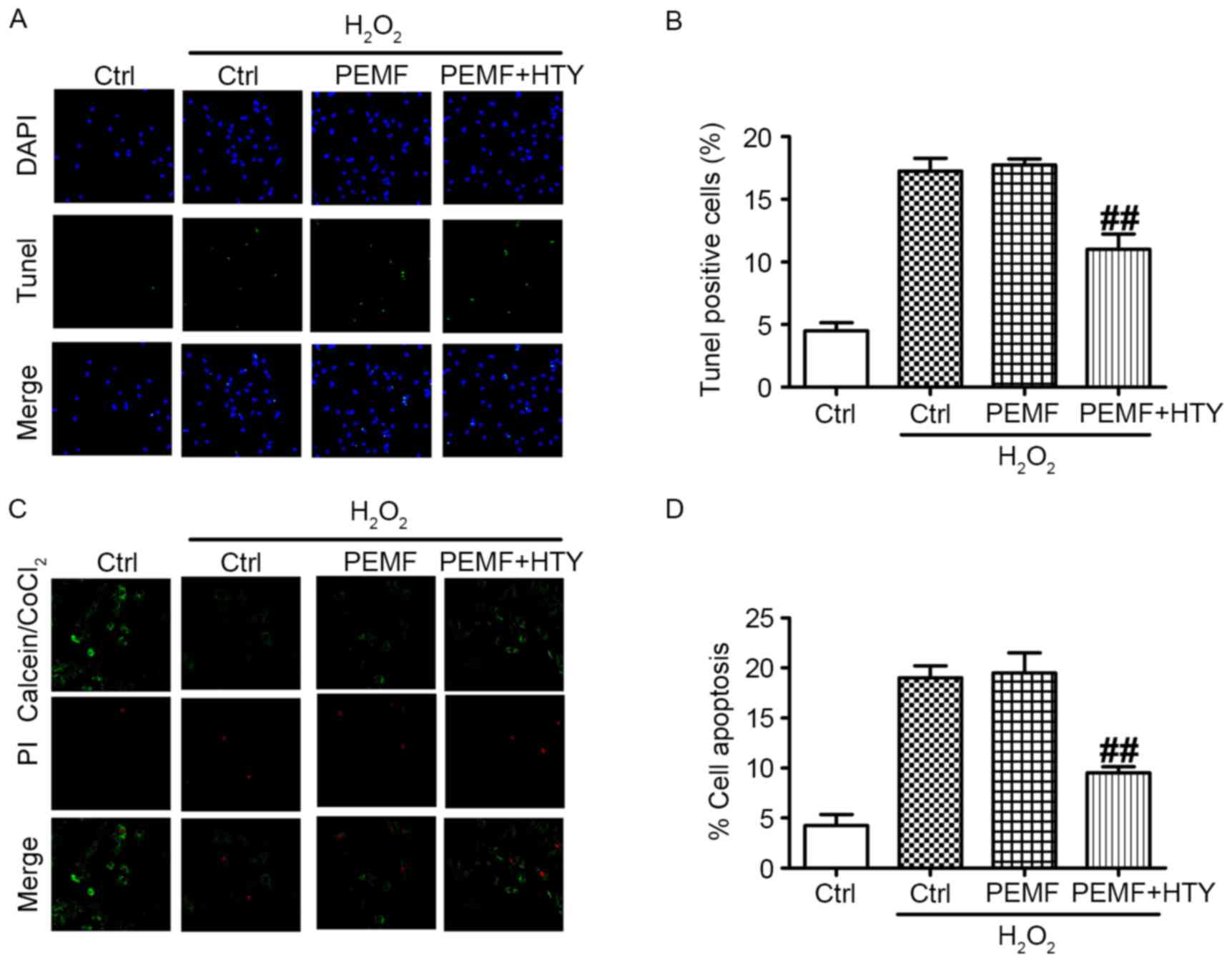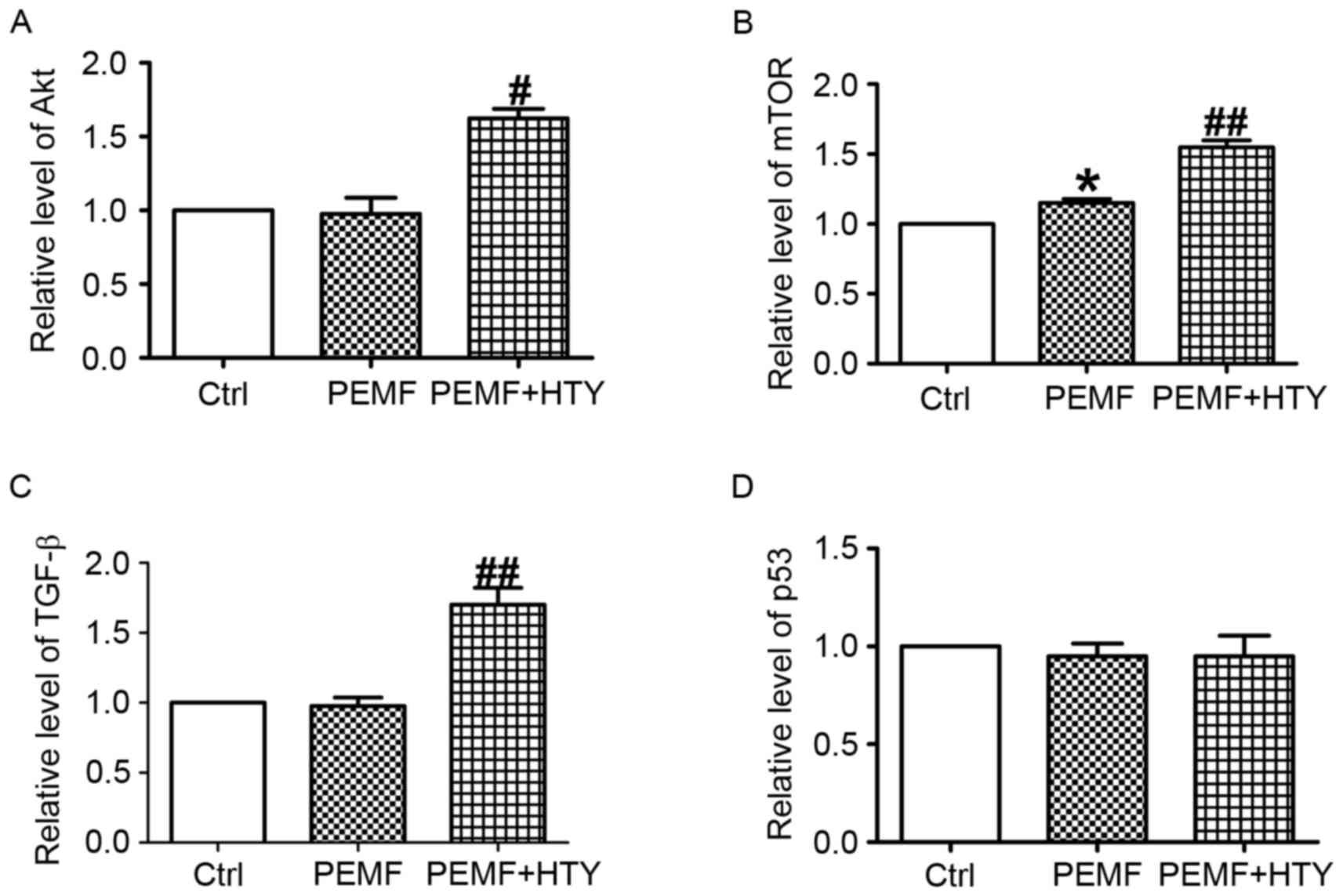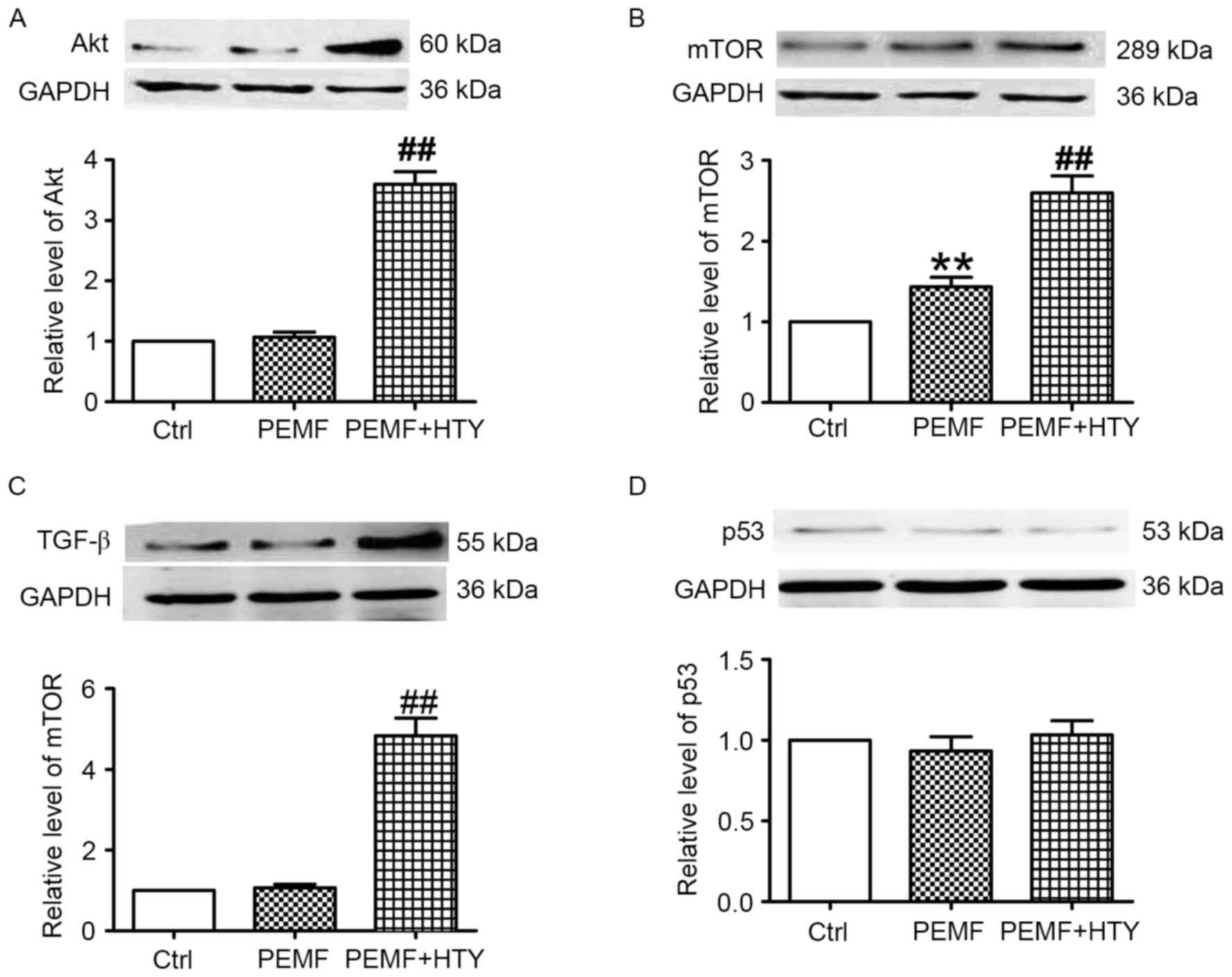Hydroxytyrosol contributes to cell proliferation and inhibits apoptosis in pulsed electromagnetic fields treated human umbilical vein endothelial cells in vitro
- Authors:
- Published online on: October 3, 2017 https://doi.org/10.3892/mmr.2017.7701
- Pages: 8826-8832
-
Copyright: © Cheng et al. This is an open access article distributed under the terms of Creative Commons Attribution License.
Abstract
Introduction
Wound healing is clinically defined as the completion of the closure of the wounded skin area, which is an interactive and dynamic process. It includes phases of hemostasis, cellular proliferation, inflammation, angiogenesis, matrix synthesis and remodeling, and formation of granulation tissue (1). The evolution of the wound healing process involves a series of phenomena which represent attempts in reestablishing the anatomical structure and function of the normal tissue. One aspect of wound repair that has always been considered to be essential for adequate healing is the creation of new vasculature via angiogenesis (2).
Understanding the correct sequence of molecular and cellular processes that occur during wound healing is critical for the development of novel treatments. Previous studies have demonstrated that pulsed electromagnetic fields (PEMFs) are capable of altering the structure of the cell membranes, and diversifying the permeability of different ion channels and the potential of the cellular membranes. At the molecular and cellular level, PEMFs have been advocated to exert a direct effect on the production of proteins and promote the synthesis of extracellular matrix proteins that regulate gene transcription (3). Additionally, previous studies have suggested that the process of angiogenesis, both in vivo and in vitro, may be influenced by various forms of electrical stimulation, including direct current, combined electromagnetic fields and PEMFs (4). In another study, Athanasiou et al (3) demonstrated that short duration PEMFs appear to facilitate and improve the quality of skin wound healing in a rat model. Nevertheless, further studies are required to define the optimal characteristics of the PEMFs, in order to ensure a faster and more effective wound healing process. Furthermore, PEMFs may also affect several membrane receptors and stimulate endothelial cells to secrete several growth factors, including vascular endothelial growth factor, connective tissue growth factor and endothelial nitric oxide synthase in vivo and in vitro (5,6). In vitro, PEMFs have been demonstrated to inhibit the process of hypoxia-induced apoptosis and augmented tube formation, migration and proliferative capacities of human umbilical vein endothelial cells (HUVECs) (7). To date, PEMFs have been applied experimentally and clinically to promote wound healing for many years (8,9).
Hydroxytyrosol (HTY), or 3,4-dihydroxyphenylethanol, is one of the hydroxyaromatic components of secoiridoids, which is a very bioactive alcoholic ortho-diphenol. Accumulating experimental, clinical and epidemiological data have indicated that HTY is antioxidant and antimicrobial and that it has beneficial effects on the cardiovascular system and in several human diseases (10,11). Zrelli et al (12) revealed that HTY upregulates heme oxygenase-1 expression by stimulating the nuclear accumulation and stabilization of nuclear factor erythroid 2-related factor 2, which leads to the wound repair of vascular endothelial cells crucial in the prevention of atherosclerosis. In another study, Scoditti et al (13) revealed that HTY could reduce inflammatory angiogenesis in cultured endothelial cells, through matrix metalloproteinase-9 and cyclooxygenase-2 inhibition, supporting a potential protective role for dietary polyphenols in atherosclerotic vascular disease and cancer. However, the exact function of HTY on endothelial cells has not been fully uncovered until now, especially in association with co-treatment with PEMFs.
When developing a wounding and healing model for PEMFs studies, endothelial cells appear to be an ideal system to investigate (14). The present study investigated the impact of the co-treatment of HYT and PEMFs on HUVEC function, and evaluated their influence on proliferation and migration in primary cultures of HUVECs. The present study also investigated the expression of functional parameters such as migration, viability and apoptosis, and the gene expression of protein kinase B (Akt), mechanistic target of rapamycin (mTOR), transforming growth factor (TGF)-β1 and p53 under the influence of different doses of HYT and PEMFs on HUVECs. The results demonstrated that PEMFs may provide novel research options in the field of wounding healing by promoting endothelial cell growth and by enhancing the healing response of the endothelium.
Materials and methods
Cell culture
HUVECs were obtained from the American Type Culture Collection (Manassas, VA, USA). The HUVECs were cultured in Dulbecco's modified Eagle's medium (DMEM) supplemented with 10% fetal bovine serum (FBS; HyClone; GE Healthcare Life Sciences, Logan, UT, USA). The cells were cultured in 95% air and 5% carbon dioxide at 37°C.
PEMF exposure
The PEMFs used in the current study was one that was clinically available for the treatment of wound healing. The devices were supplied by Electro-Biology, Inc. (Parsippany, NJ, USA). The model required a voltage of 230 V with a frequency of 50/60 Hz to generate PEMF with a maximum intensity of 0.015 T (150 Gauss) and an impulse repetition frequency of up to 100 Hz. At the beginning of the experiment, the intensity of the magnetic fields generated inside the solenoid was measured with a Gaussimeter PCE-G28 (PCE Group, Albacete, Spain) with a triaxial probe. The intensity of the electromagnetic field used in this protocol was 2.25 mT, the frequency of the bursts was 50 Hz and the application time was 15 min. PEMF irradiation was performed on days 1, 2, 3 and 4 of culture, with the solenoid inside the incubator, under the same conditions of temperature.
Cell viability assay
The cell viability was calculated using the Cell Counting kit-8 (CCK-8; Beyotime Institute of Biotechnology, Jiangsu, China) according to the manufacturer's protocol. Briefly, HUVECs (1×104/well) were seeded into 96-well plates in DMEM supplemented with 10% FBS for different time points. Following this, the cells were exposed to PEMFs at days 0, 1, 2, 3 or 4, or treated with HTY (0, 10, 30, 50, 100, 150 µM) at day 2, or treated with a combination on days 0, 1, 2 or 4. Finally, the viable cells were detected using by CCK-8 assay, where the absorbance for each sample was assessed at 450 nm using a microplate reader (Tecan, Männedorf, Switzerland).
Cell migration analysis
For the migration assay, cells were treated with PEMFs/HTY or a combination for 48 h, and then re-suspended cells were removed on the top layer of a Transwell chamber with 8 µm pores (EMD Millipore, Billerica, MA, USA). The lower layer of the chamber contained 10% FBS as a chemoattractant. The chambers were placed at 37°C in 5% CO2 for 48 h. Non-migrating cells on the top of the membrane were removed with cotton swabs. Cells that had migrated to the bottom were fixed with 95% ethanol, stained with 0.2% crystal violet staining (Sigma-Aldrich; Merck KGaA, Darmstadt, Germany), and imaged by bright-field microscopy (IX71; Olympus Corporation, Tokyo, Japan) and counted using Image-Pro Plus v6.0 software (Media Cybernetics, Inc., Rockville, MD, USA). Each experiment was performed in triplicate.
TUNEL assay
DNA fragmentation in HUVECs was detected by TUNEL assay using a Cell Death Detection kit (Roche Applied Science, Mannheim, Germany). Briefly, air-dried slides were fixed with 4% paraformaldehyde for 30 min at room temperature and cleaned three times with PBS for 10 min, and then permeabilized with 1% Triton X-100 for 4 min at 4°C. Then, the TdT-labelled nucleotide mix was added to each slide and incubated at 37°C for 60 min in dark. Slides were washed twice with PBS and then counterstained with 10 mg/ml 4,6-diamidino-2-phenylindole for 5 min at 37°C.
Calcein-acetoxymethyl (AM)/propidium iodide (PI) dual-staining assay
A calcein-AM/PI dual-staining assay (Invitrogen; Thermo Fisher Scientific, Inc., Waltham, MA, USA) was performed to verify the effect of PEMFs and HTY on cell apoptosis. The calcein-AM/PI/CoCl2 assay relies on the intracellular esterase activity within living cells. Living cells are stained with green fluorescence, and dead cells are stained red by PI. HUVECs were treated with PEMFs and HTY for 48 h in DMEM with 10% FBS. Fluorescence was analyzed by microscopy (Olympus Corporation).
Reverse transcription quantitative-polymerase chain reaction (RT-qPCR)
Total RNA samples from cultured HUVECs were isolated using TRIzol reagent (Invitrogen; Thermo Fisher Scientific, Inc.), according to the manufacturer's protocols. Total RNA (1 µg) was then reverse transcribed using the High-Capacity cDNA Reverse Transcription kit (Toyobo Co., Ltd., Osaka, Japan) to obtain cDNA, with the following temperature protocol: 37°C for 15 min, then 98°C for 5 min. The SYBR Green PCR Master Mix kit (Toyobo Co., Ltd.) was used for qPCR to quantify RNA levels of silent information regulator 1 (SIRT1). GAPDH served as an internal control. qPCR was performed on the 7300 FAST Real-Time PCR system (Applied Biosystems; Thermo Fisher Scientific, Inc.) for 40 cycles. The thermocycling conditions were as follows: 95°C for 10 min followed by 95°C for 15 sec, then 40 cycles of 60°C for 30 sec and 72°C for 30 sec. The results were quantified using the 2−ΔΔCq method (15). Primer sequences were as follows: Akt, forward, 5′-GGTGATCCTGGTGAAGGAGA-3′ and reverse, 5′-CTTAATGTGCCCGTCCTTGT-3′; mTOR, forward, 5′-TTCTGGTGCGACACCGAATC-3′ and reverse 5′-CATCGGGTTGTAGGCCTGTG-3′; TGF-β1, forward, 5′-CCCCGAGGGCGGCATG-3′ and reverse, 5′-CATGCCGCCCTCGGGG-3′; p53, forward, 5′-ACGACGGTGACACGCTTCCCTG-3′ and reverse, 5′-CGCTAGGATCTGACTGCGGCTC-3′; and GAPDH, forward, 5′-GCTCTCTGCTCCTCCTGTTC-3′ and reverse, 5′-ACGACCAAATCCGTTGACTC-3′.
Scratch-wound assay
The confluent HUVECs cultured in 6-well plates were scratched with pipette tips, which led to a 1-mm-wide lane per well, and the ablate cells were cleaned with PBS. Subsequently, the cells were treated with or without hydroxytyrosol (Shanghai Pureone Biotechnology Co., Ltd, Shanghai, China) with DMEM supplemented with 10% FBS at 37°C for 1–4 days. Wounded areas were imaged by bright-field microscopy (magnification, ×200; IX71 Olympus) and analyzed using Image-Pro Plus v6.0 software (Media Cybernetics, Inc.) at time point zero and after a 48 h treatment.
Western blot analysis
HUVECs were treated with PEMFs or HTY in DMEM with 10% FBS for 48 h. Proteins were solubilized and extracted with 200 µl lysis buffer (Beyotime Institute of Biotechnology) and kept for 20 min on ice. Following this, the lysates were sonicated and centrifuged at 12,000 × g for 15 min at 4°C, and the insoluble fractions were discarded. Equal amounts of protein (~60 µg) from each sample were separated by 10% SDS-PAGE, and transferred onto a nitrocellulose membrane (EMD Millipore). After a 1 h incubation with 5% non-fat dry milk powder, the membranes were probed with the following primary antibodies: anti-GADPH (1:5,000 dilution; cat. no. 97166), anti-Akt (1:2,000; cat. no. 9272), anti-mTOR (1:1,000; cat. no. 2983), anti-human TGF-β1 (1:2,000; cat. no. 3711) and anti-p53 (1:2,000; cat. no. 2524; all Cell Signaling Technology, Inc., Danvers, MA, USA) overnight at 4°C. Membranes were washed three times for 10 min in PBS containing 0.5% Tween-20, then incubated for 1 h at room temperature with the following Alexa Fluor™-conjugated secondary antibodies: IRDye® 800CW goat anti-rabbit IgG conjugated to IRDye® 800CW (cat. no. 926-32211; 1:10,000 dilution; LI-COR Biosciences, Lincoln, NE, USA) and IRDye® 800CW goat anti-mouse IgG conjugated to IRDye® 800CW (cat. no. 926-32210; 1:10,000 dilution; LI-COR Biosciences). The bands were visualized using the Odyssey Imaging system (LI-COR Biosciences) and semi-quantified using the Odyssey software version 3.0. Relative protein expression was normalized to that of GAPDH, which was used as an internal control, and experiments were repeated three times, unless otherwise stated.
Statistical analysis
All quantitative data are expressed as the mean ± standard error. Statistical analysis was performed using SPSS version 19.0 (IBM Corp., Armonk, NY, USA). A Student's t-test or one-way analysis of variance followed by Dunnett's test was performed where appropriate. P<0.05 was considered to indicate a statistically significant difference.
Results
HTY promotes HUVEC proliferation mediated by PEMFs in a time-dependent manner
As endothelial cell proliferation represents one of the critical processes for wound healing, the present study investigated the effect of PEMFs for <24 h on the cell proliferation of HUVECs. PEMFs increased the proliferation rate of HUVECs in a time-dependent manner, significantly so after 72 and 96 h of exposure (Fig. 1A). In order to investigate whether HTY could promote proliferation induced by treatment with PEMFs, different dosages of HTY was used. The results demonstrated that 50, 100 and 150 µM HTY could markedly reduce cell proliferation at the 24 h time point (Fig. 1B). Therefore, 30 µM HTY was selected for following experiments. As presented in Fig. 1C, HTY could substantially increase the cell proliferation in PEMF-treated cells at the 24 h time point, while PEMF treatment alone produced no response on cell proliferation.
HTY enhances HUVEC migration induced by PEMF
To further determine the effect of HTY on cell migration, Transwell and scratch wound assays were performed. The results demonstrated that the number of migratory cells was significantly enhanced following combined HTY and PEMF treatment, compared with the control and PEMF treatment only (Fig. 2).
Co-treatment of HTY and PEMFs has anti-apoptosis effects, and ameliorates mitochondrial dysfunction induced by H2O2
An increase in apoptotic cells is associated with wound healing. Therefore, a TUNEL assay was performed. Briefly, HUVECs were treated with HTY/PEMFs or combined with H2O2, (representative images in Fig. 3A). The results demonstrated that combined PEMF and HTY could significantly reduce the number of apoptotic HUVECs, while PEMF treatment alone produced no effects (Fig. 3B). In addition, calcein/PI/CoCl2 staining was used to verify cell apoptosis associated with mitochondrial dysfunction (representative images are presented in Fig. 3C). In Fig. 3D, apoptotic cells were markedly decreased in the PEMF- and HTY-treated group, while PEMFs administered alone had no effect on cell apoptosis. Therefore, the anti-apoptotic effect of HTY may be associated with ameliorating mitochondrial dysfunction.
HTY increases the transcription activities of Akt, mTOR and TGF-β, but not p53, in HUVECs
To clarify the anti-apoptosis and pro-proliferation effects of HTY following PEMF treatment, the mRNA expression levels of Akt, mTOR, TGF-β and p53 were detected. Combined PEMF and HTY treatment significantly increased the mRNA expression levels of Akt (Fig. 4A), mTOR (Fig. 4B) and TGF-β (Fig. 4C) compared with the control. In addition, the mRNA expression of mTOR was substantially elevated following both HTY and PEMF treatment (Fig. 4B). Notably, no significant differences were observed in the mRNA expression levels of p53 (Fig. 4D).
HTY increases the protein expression levels of Akt, mTOR and TGF-β, but not p53, in PEMF-treated HUVECs
Western blotting was used to assess the protein expression levels of Akt, mTOR and TGF-β in PEMF- and HTY-treated HUVECs. PEMF treatment alone had no effect on the protein expression levels of Akt; however, combined treatment with HTY significantly upregulated these levels (Fig. 5A). PEMF treatment alone upregulated the protein expression levels of mTOR, and this effect was further enhanced by combined treatment with HTY (Fig. 5B). TGF-β protein expression levels demonstrated the same pattern of effect as Akt (Fig. 5C). Both HTY and PEMF had no effect on the protein expression level of p53.
Discussion
In the present study, several novel findings were demonstrated. To the best of our knowledge, we demonstrated for the first time that HTY promotes HUVEC proliferation mediated by PEMFs in a time-dependent manner. Secondly, the data from the study revealed that HTY and PEMFs serve synergistic roles in anti-apoptosis and ameliorating mitochondrial dysfunction induced by H2O2 incubation. Thirdly, to clarify the anti-apoptosis and pro-proliferation effects of HTY following PEMF treatment, the mRNA and protein expression levels of Akt, mTOR, TGF-β and p53 were detected. It was demonstrated that HTY increases the transcription activities of Akt, mTOR and TGF-β, but not p53, in HUVECs in vitro. To the best of our knowledge, the present study was the first to reveal the molecular mechanism of co-treatment with PEMFs and HTY on the biological characteristics in HUVECs. These results not only facilitate understanding of the mechanisms underlying the effects of HTY on HUVECs, but also improve the view of co-treatment of HTY and PEMFs that may serve as potential therapeutic strategy in wound healing in the future.
Previous studies have demonstrated that PEMFs are a non-invasive and non-pharmacological intervention, and have been reported to repair damaged tissue (16–18). Several clinical studies have demonstrated that PEMFs can effectively alleviate tissue swell, traumatic pain and promote wound healing (19,20). Guerriero et al (21) described the first reported case of an innovative PEMF therapy, emysimmetric bilateral stimulation (EBS), used to successfully treat refractory skin ulcers in two elderly and fragile patients. They demonstrated a supportive role of PEMFs in the treatment of skin ulceration in diabetes, which was suggestive of a potential benefit of EBS for this clinical condition. HTY is a major phenolic compound in virgin olive oil in both free and complex forms. Catalán et al (22) revealed the protective effect of HTY and its predominant plasmatic human metabolites, synthetized for the first time by using an intestinal cell model, which may be responsible in part for the protection against endothelial dysfunction. However, no previous findings have suggested that the combined treatment of PEMFs with HTY is a potentially promising therapeutic strategy for treating wound healing. To further investigate the mechanism of PEMF- and HTY-mediated neovascularization, the present study investigated the effects of co-treatment of PEMF and HTY on endothelial biological modification in vitro. The synergistic effect of PEMFs and HTY were identified, which may improve multiple endothelial functions including migration, proliferation, anti-apoptosis and mitochondrial dysfunction, suggesting the therapeutic potential of PEMF- and HTY-combined treatment on pre-existing endothelial vasculature. However, other mechanisms involved in PEMF- and HTY-mediated neovascularization may exist; therefore, several limitations of the current research should be highlighted. For example, the present study used cell models, and the findings may not be extrapolated directly to animal models and humans. The gene activation and protein production of the HTY-stimulated HUVECs will require further study to confirm the beneficial effects of PEMFs on wound healing in vivo. Precaution should be taken when applying the results of this study to patients. Nevertheless, these results provide a basis for future studies to investigate whether the effects of co-treatment of PEMFs and HTY are also applicable in a clinical setting.
In conclusion, the results of the present study revealed that combined exposure of PEMFs and HTY to HUVECs demonstrated protective effects on proliferation, migration and apoptosis in vitro, implicating the potential benefits of this treatment for wound healing in the future.
References
|
Janis JE, Attinger CE and Lavery L: Introduction to ‘current concepts in wound healing: Update 2016’. Plast Reconstr Surg. 138(3 Suppl): 7S–8S. 2016. View Article : Google Scholar : PubMed/NCBI | |
|
Yoshida S, Yoshimoto H, Hirano A and Akita S: Wound healing and angiogenesis through combined use of a vascularized tissue flap and adipose-derived stem cells in a rat hindlimb irradiated ischemia model. Plast Reconstr Surg. 137:1486–1497. 2016. View Article : Google Scholar : PubMed/NCBI | |
|
Athanasiou A, Karkambounas S, Batistatou A, Lykoudis E, Katsaraki A, Kartsiouni T, Papalois A and Evangelou A: The effect of pulsed electromagnetic fields on secondary skin wound healing: Aexperimental study. Bioelectromagnetics. 28:362–368. 2007. View Article : Google Scholar : PubMed/NCBI | |
|
Monache S Delle, Alessandro R, Iorio R, Gualtieri G and Colonna R: Extremely low frequency electromagnetic fields (ELF-EMFs) induce in vitro angiogenesis process in human endothelial cells. Bioelectromagnetics. 29:640–648. 2008. View Article : Google Scholar : PubMed/NCBI | |
|
Li F, Lei T, Xie K, Wu X, Tang C, Jiang M, Liu J, Luo E and Shen G: Effects of extremely low frequency pulsed magnetic fields on diabetic nephropathy in streptozotocin-treated rats. Biomed Eng Online. 15:82016. View Article : Google Scholar : PubMed/NCBI | |
|
Martino CF, Perea H, Hopfner U, Ferguson VL and Wintermantel E: Effects of weak static magnetic fields on endothelial cells. Bioelectromagnetics. 31:296–301. 2010.PubMed/NCBI | |
|
Li RL, Huang JJ, Shi YQ, Hu A, Lu ZY, Weng L, Wang SQ, Han YP, Zhang L, Hao CN and Duan JL: Pulsed electromagnetic field improves postnatal neovascularization in response to hindlimb ischemia. Am J Transl Res. 7:430–444. 2015.PubMed/NCBI | |
|
Cheing GL, Li X, Huang L, Kwan RL and Cheung KK: Pulsed electromagnetic fields (PEMF) promote early wound healing and myofibroblast proliferation in diabetic rats. Bioelectromagnetics. 35:161–169. 2014. View Article : Google Scholar : PubMed/NCBI | |
|
Goudarzi I, Hajizadeh S, Salmani ME and Abrari K: Pulsed electromagnetic fields accelerate wound healing in the skin of diabetic rats. Bioelectromagnetics. 31:318–323. 2010.PubMed/NCBI | |
|
Lamy S, Ben Saad A, Zgheib A and Annabi B: Olive oil compounds inhibit the paracrine regulation of TNF-alpha-induced endothelial cell migration through reduced glioblastoma cell cyclooxygenase-2 expression. J Nutr Biochem. 27:136–145. 2016. View Article : Google Scholar : PubMed/NCBI | |
|
Morbidelli L: Polyphenol-based nutraceuticals for the control of angiogenesis: Analysis of the critical issues for human use. Pharmacol Res. 111:384–393. 2016. View Article : Google Scholar : PubMed/NCBI | |
|
Zrelli H, Kusunoki M and Miyazaki H: Role of hydroxytyrosol-dependent regulation of HO-1 expression in promoting wound healing of vascular endothelial cells via Nrf2 De Novo synthesis and stabilization. Phytother Res. 29:1011–1018. 2015. View Article : Google Scholar : PubMed/NCBI | |
|
Scoditti E, Calabriso N, Massaro M, Pellegrino M, Storelli C, Martines G, De Caterina R and Carluccio MA: Mediterranean diet polyphenols reduce inflammatory angiogenesis through MMP-9 and COX-2 inhibition in human vascular endothelial cells: A potentially protective mechanism in atherosclerotic vascular disease and cancer. Arch Biochem Biophys. 527:81–89. 2012. View Article : Google Scholar : PubMed/NCBI | |
|
Ferroni L, Bellin G, Emer V, Rizzuto R, Isola M, Gardin C and Zavan B: Treatment by Therapeutic Magnetic Resonance (TMR) increases fibroblastic activity and keratinocyte differentiation in an in vitro model of 3D artificial skin. J Tissue Eng Regenerat med. 11:1332–1342. 2015. View Article : Google Scholar | |
|
Livak KJ and Schmittgen TD: Analysis of relative gene expression data using real-time quantitative PCR and the 2(-Delta Delta C(T)) method. Methods. 25:402–408. 2001. View Article : Google Scholar : PubMed/NCBI | |
|
Goto T, Fujioka M, Ishida M, Kuribayashi M, Ueshima K and Kubo T: Noninvasive up-regulation of angiopoietin-2 and fibroblast growth factor-2 in bone marrow by pulsed electromagnetic field therapy. J Orthop Sci. 15:661–665. 2010. View Article : Google Scholar : PubMed/NCBI | |
|
Osti L, Buono AD and Maffulli N: Pulsed electromagnetic fields after rotator cuff repair: A randomized, controlled study. Orthopedics. 38:e223–e228. 2015. View Article : Google Scholar : PubMed/NCBI | |
|
Kim YT, Hei WH, Kim S, Seo YK, Kim SM, Jahng JW and Lee JH: Co-treatment effect of pulsed electromagnetic field (PEMF) with human dental pulp stromal cells and FK506 on the regeneration of crush injured rat sciatic nerve. Int J Neurosci. 125:774–783. 2015. View Article : Google Scholar : PubMed/NCBI | |
|
Bagnato GL, Miceli G, Marino N, Sciortino D and Bagnato GF: Pulsed electromagnetic fields in knee osteoarthritis: A double blind, placebo-controlled, randomized clinical trial. Rheumatology (Oxford). 55:755–762. 2016. View Article : Google Scholar : PubMed/NCBI | |
|
Menini M, Bevilacqua M, Setti P, Tealdo T, Pesce P and Pera P: Effects of pulsed electromagnetic fields on swelling and pain after implant surgery: A double-blind, randomized study. Int J Oral Maxillofac Surg. 45:346–353. 2016. View Article : Google Scholar : PubMed/NCBI | |
|
Guerriero F, Botarelli E, Mele G, Polo L, Zoncu D, Renati P, Sgarlata C, Rollone M, Ricevuti G, Maurizi N, et al: Effectiveness of an innovative pulsed electromagnetic fields stimulation in healing of untreatable skin ulcers in the frail elderly: Two case reports. Case Rep Dermatol Med. 2015:5765802015.PubMed/NCBI | |
|
Catalán Ú, López de Las Hazas MC, Rubió L, Fernández-Castillejo S, Pedret A, de la Torre R, Motilva MJ and Solà R: Protective effect of hydroxytyrosol and its predominant plasmatic human metabolites against endothelial dysfunction in human aortic endothelial cells. Mol Nutr Food Res. 59:2523–2536. 2015. View Article : Google Scholar : PubMed/NCBI |



